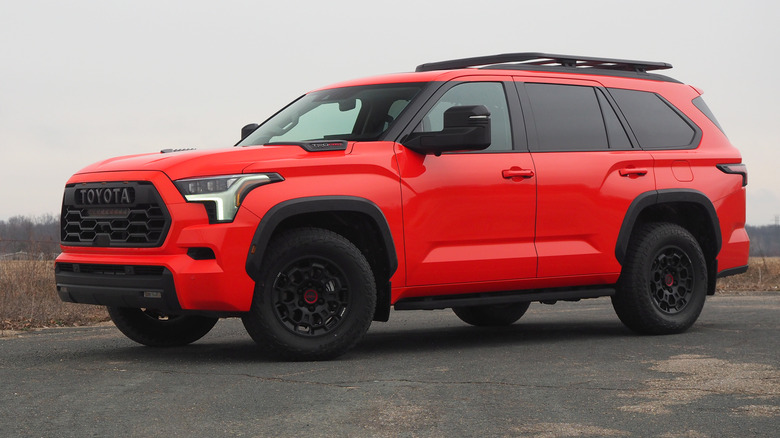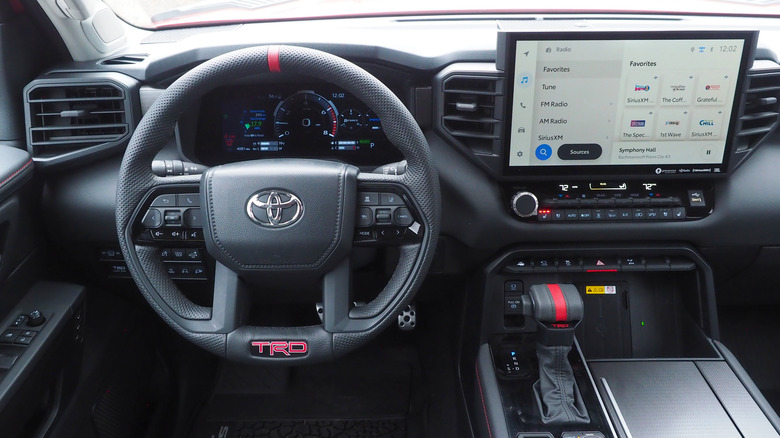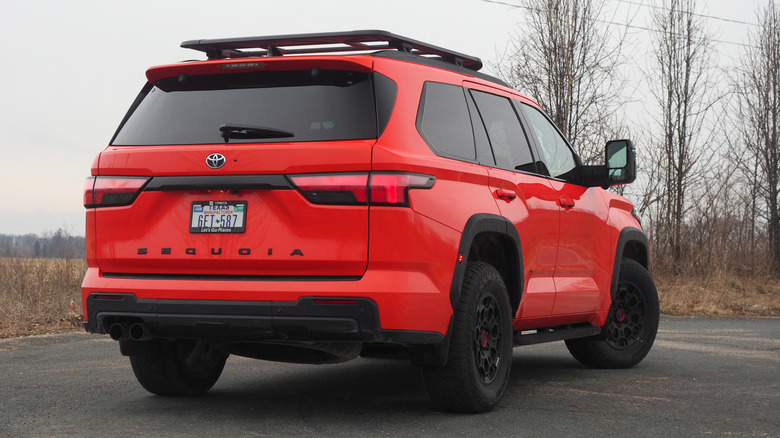The Biggest Change On The 2023 Sequoia That Some Toyota Fans Aren't Happy About
The 2023 Toyota Sequoia is more powerful, more striking in its design, and generally more capable than its predecessor, but that didn't stop some fans of the three-row SUV from being disappointed. While Toyota's burly people-carrier has been well-received by reviewers and owners alike, what's under the hood has proved divisive. Turns out, some people really aren't happy that the old Sequoia's V8 was put out to pasture.
There are plenty of reasons to like a big V8 engine, and not just because displacement and cylinder count have long been a metric of success for vehicles. The usual justification is torque, especially for naturally-aspirated — not turbocharged — engines. Rather than having to wait for peak torque to arrive from a smaller, turbocharged engine, which is dependent on the turbo spooling up first, big V8 engines of the sort which find their way into similarly big SUVs and trucks generally unlock their maximum twist at lower engine speeds.
It's that which gives plenty of grunt from a standing start or at relatively low driving speeds, but it also pays dividends for things like towing. That's when you want lashings of torque without having to wait for it. The downside to an eight-cylinder, high-displacement engine probably doesn't need much explaining: they're thirsty beasts. Fuel consumption may not be the primary factor concerning big truck and SUV buyers, but running costs — not to mention emissions — definitely suffer when you're feeding a V8. Miles per gallon measured in the low to mid-teens are often a best-case scenario, not an outlier.
Electrification to the rescue
Toyota's fix here is a judicious squirt of electrification. No, nobody is going to confuse the Sequoia for a Prius, but the same strategy of pairing gas and electric power to get some of the best of both worlds is present in this three-row SUV. A big vehicle gets a big engine name: the 3.5-liter twin-turbo V6 hybrid i-FORCE MAX.
Admittedly, the gas part of this electrified party is still a sizable thing: a 3.5-liter V6 onto which Toyota bolts not one, but two turbochargers. In between that and the 10-speed automatic transmission, however, is an electric motor. Combined, the two sources muster a whopping 437 horsepower and 583 lb-ft of torque.
That's a lot, but equally important is how rapidly all that torque arrives: at just 2,400 rpm. Contrast that with the old Sequoia and its V8, and you see the improvement easily. The model year 2022 SUV managed 401 lb-ft — considerably less than this hybrid V6 packs — and it arrived later, at 3,600 rpm.
A welcome economy boost
More power, more immediately seems like a recipe most drivers could get behind, but that's not the hybrid's only advantage. The V8 Sequoia 4WD is EPA rated for 13 mpg in the city, 17 mpg on the highway, and 14 mpg combined. Compared to the average new car, the U.S. Environmental Protection Agency says, you'll spend $9,000 more on gas over five years. The hybrid Sequoia 4WD, meanwhile, is rated at 19 mpg in the city, 22 mpg on the highway, and 20 mpg combined. You'll still spend more on gas than the average new vehicle, but at $3,500 over the first five years, it's almost a third of what the V8 would've set you back.
Now, in practice your economy figures will depend on how heavy your right foot is, how many people you regularly transport, and what sort of cargo and trailering you're doing. Still, the ability to coax out a whole lot more miles per gallon — and without having to mess with EV modes to do so — while getting the advantage of an electrified vehicle's surprising perkiness from a standing start seems like a win-win.
There's not even a towing compromise — the 2023 Sequoia is rated for up to 9,520 pounds (trim depending) while the 2022 Sequoia maxes out at 7,400 pounds. In short, while there's an undeniable charm to a classic V8, the hybrid Toyota comfortably outperforms its predecessor's engine in every metric. That's a fact even the most passionate of Sequoia enthusiasts should be paying attention to.


